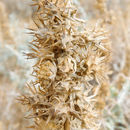More info for the terms:
association,
codominant,
cover,
density,
natural,
treeBurrobush is a dominant or codominant member of most plant
communities in the Sonoran and Mojave deserts. It usually occurs in
open, species-poor communities with creosote bush (Larrea tridentata).
At the northern boundary of burrobush, in the transition zone
between the Mojave and Great Basin deserts, associated species of the
creosote bush-burrobush community include wolfberry (Lycium spp.),
range ratany (Krameria parvifolia), Mojave yucca (Yucca schidigera),
California jointfir (Ephedra funera), spiny hopsage (Grayia spinosa),
and winterfat (Krascheninnikovia lanata) [
38,
47]. The density of white
bursage is about 2,500 plants per hectare [
3,
47].
Approximately 70 percent of the Mojave Desert is covered with open or
very open stands of creosote bush and burrobush [
15,
29,
40].
Associated species in the Mojave Desert include desertsenna (Cassia
armata), Nevada ephedra (Ephedra nevadensis), white burrobrush
(Hymenoclea salsola), and wolfberry [
22].
In the Sonoran Desert, associated members of the creosote bush-white
bursage community are acacia (Acacia paucipina), fourwing saltbush
(Atriplex canescens), ocotillo (Fouquieria splendens), big galleta
(Hilaria rigida), cholla (Opuntia spp.) and western honey mesquite
(Prosopis glandulosa var. torreyana) [
40]. In the Arizona Upland
Subdivision of the Sonoran Desert, the density of burrobush is 549.7
plants per hectare and burrobush cover is 2.7 percent. In the Lower
Colorado River Valley, the density of burrobush is 84 plants per
hectare and burrobush cover is 0.1 percent [
29].
In addition to the creosote bush-burrobush association, burrobush
is a member of the following associations: Joshua tree (Yucca
brevifolia)-big galleta [
24], saguaro (Carnegiea gigantea)-paloverde
(Cercidium spp.) [
39], Sonoran creosote bush scrub, Mojave creosote bush
scrub, and Mojave mixed woody scrub [
22].
Publications listing burrobush as a dominant or codominant species
include:
Sonoran Desert [
10]
Preliminary descriptions of the terrestrial natural communities of California
[
22]
Vegetation of the Santa Catalina Mountains: community types and
dynamics [
34]
Mojave Desert scrub vegetation [
60]

